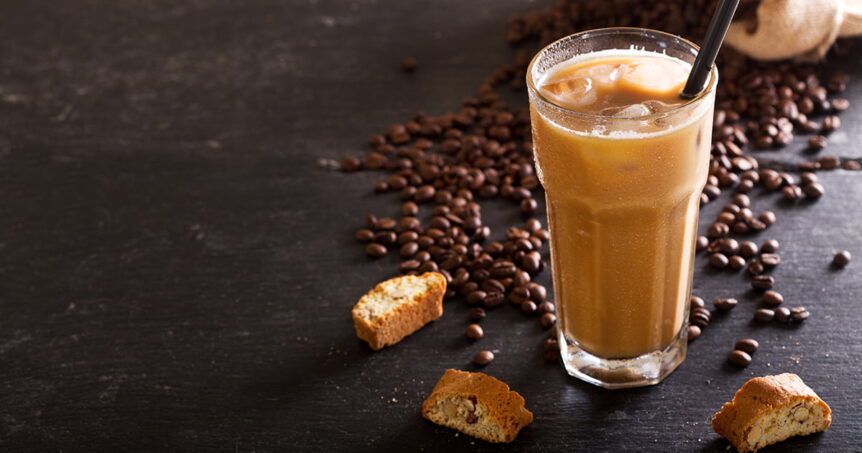Iced coffee — A refreshing mix of coffee brew and ice, perfect for hot summers. Think of it as the coffee world’s rebel sibling, chillin’ on the rocks with its own gang of flavors and flair.
But not all iced coffee is the same. We’ve cold brews, Japanese-style iced coffee, and many others to choose from. In this guide, we’ve explored different variants of iced coffee, their exciting history, and delectable recipes that you can easily make at home.
Here’s everything you need to know about iced coffee. Let’s dive in.
What Is Iced Coffee?
Iced coffee is an umbrella term for a large variety of cold coffee beverages made with numerous methods and recipes. It’s a popular summer drink and offers a completely different yet equally delicious taste. To avoid any confusion, here’s a list of three popular iced coffee variants.
Cold Brew
As the name suggests, cold brew is made with coffee beans immersed in cold water and cooled for 12 to 24 hours in a refrigerator. The resulting extract is less acidic yet full-bodied and packed with caffeine.
Cold Filter Coffee
Also called Japanese-style iced coffee, it’s made with the pour-over method. The only difference is that the hot extract drips over ice cubes, and coffee to water ratio is kept higher to avoid watering down the flavor.
Iced Coffee
A simple iced coffee is a regular hot coffee served chilled with ice cubes. It’s also very diluted, and you miss out on key flavors.
What is Iced Coffee Made Of?
An iced coffee has similar ingredients to hot coffee, which are essentially water, coffee beans, milk, flavor syrups, and sugar. The major difference is the chilled serving temperature and preparation method. You’ll find many different version of it on different coffee shops.
What Kind of Coffee Beans are Used for a Good Iced Coffee?
A good thing about cold brew coffee is that it tastes good with any type of coffee beans, ranging from light to dark roast. Just be sure to use a medium-coarse grind size.
For the filter-style iced coffee, use light or medium roast coffee beans with medium or fine grind size, as it really helps in extracting the flavor during the pour-over method. Also, coffee with notes of fresh berries or citrus fruits will make it more refreshing.
How Much Caffeine Is in Iced Coffee?
Typically, iced coffee is served in higher quantities and has a larger caffeine content than hot coffee. A 16 oz cup (473 ml) of cold brew has about 200 mg, while iced coffee (Japanese filter style) contains 170 mg of caffeine. In comparison, a single shot of espresso contains 63 mg.
How Many Calories Are in Iced Coffee?
A 16 oz cup of black iced coffee has a mere ~5 calories, which is almost negligible. The calorie count only increases if you add milk, cream, or sweeteners to the drink. In comparison, an iced latte contains 130 calories.
The History of Iced Coffee
Iced coffee has a rich and intriguing history behind it. According to Claudia Roden, an award-winning cookbook writer, the first cold coffee beverage was “Mazagran.”
Our story starts in 1837 when French colonial forces took control of Algeria, also called the “Treaty of Tafna.”French troops stayed in a fortress called “Mazagran,” where they prepared a cold coffee drink using only coffee syrup with cold water, probably because of a shortage of heat, alcohol, and milk during wartime.
The French soldiers actually enjoyed it, and once the conquest was over, they went back to Paris and demanded the local coffee shops to serve them a similar cold coffee drink in large cups.
The drink started to get traction in 1840 and slowly became an integral part of local coffee culture now known as “Mazagrin.” Similar coffee drinks like “granita al caffe” also started popping up in Italy.
However, the modern trend of iced coffee started when the Joint Coffee Trade Publicity Committee of the United States ran a popular marketing campaign for iced coffee in 1920. Later, popular food chains like Dunkin Donuts and Starbucks made it trendy by including cold coffee in their menus.
Who Invented Iced Coffee?
Iced coffee isn’t a specific drink. Therefore, it can’t be attributed to a single inventor. However, legends say that during the conquest of Algeria in 1837, French troops came up with this cold concoction. As time passed, people started experimenting with recipes, and now we have tons of delicious cold coffee drinks to enjoy.
Where is Iced Coffee From?
The iced coffee first emerged in Algeria, and later, the Western world adopted it. Over time, different coffee cultures evolved cold coffee drinks, leading to many tasty recipes we enjoy today.
Here is the breakthrough of Iced coffee in different countries.
Australia
Iced coffee is pretty popular in Australia and is often served with coffee syrup, cocoa powder, and cream. In some regions, it has more sales than Coca-Cola.
United States
In American culture, we have cold brew coffee, which is extremely popular. Many mainstream brands like BurgeKing, Dunkin Donuts, and Starbucks have one on their menu.
Canada
Canadians really like Iced Cappuccinos or Ice Capps in local lingo, which Tim Hortons sell.
Germany
In Germany, Eiskaffee (iced coffee) is a milk-based coffee served chilled with ice cream and whipped cream on top.
Greece
Frappe is a go-to drink for many Greeks, simply made with instant coffee, cream, and ice cubes.
How To Make Iced Coffee — 3 Easy Methods
Here, we’ll explore three different types and share easy steps to make iced coffee. Beat the heat with these exciting recipes!
Method 1: Cold Brew
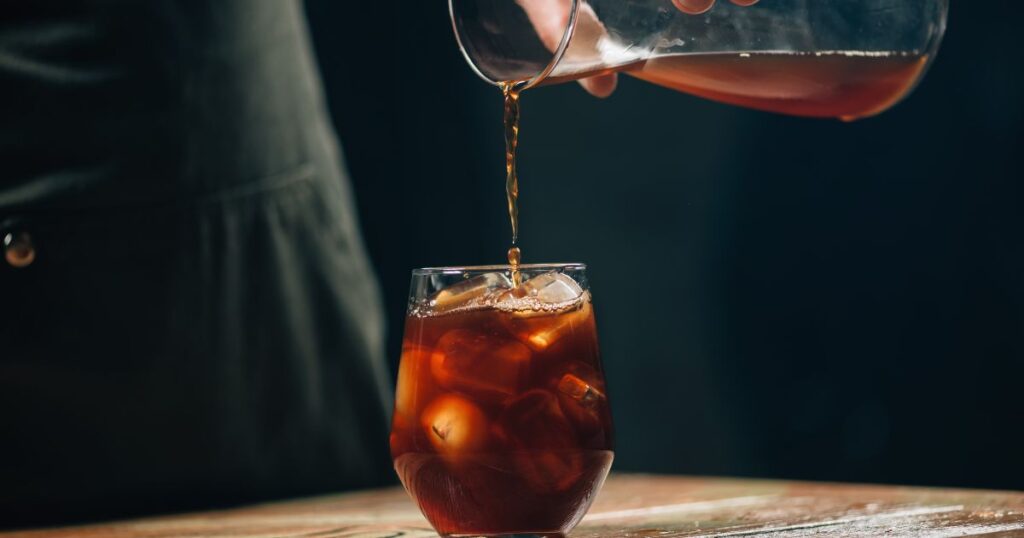
Step 1: Gather Tools and Ingredient
Cold brews are made in big batches, so you need a half-gallon jar for this. Next, grind 80 g or ½ cup of coffee beans to a medium coarse consistency. The type of roast doesn’t matter. Just maintain a coffee-to-water ratio of 1:10-15.
Step 2: Blooming Process
Now add 2 cups of hot water (95°C or 205°F) into the jar and let it sit for one minute. Give it a little stir. It’ll cause coffee grounds to bloom. After one minute of blooming, immediately add 4 cups of cold water, stir it, and then close the lid. Keep the jar in the refrigerator for 12 to 24 hours.
Step 3: Cold Brew
Take out the jar from the fridge and strain the cold coffee through a metal strainer or cheesecloth into a separate container. Add sugar and cream to your liking.
Now, enjoy your delicious cold brew!
Method 2: Iced Filter Coffee or Japanese Style Cold Coffee
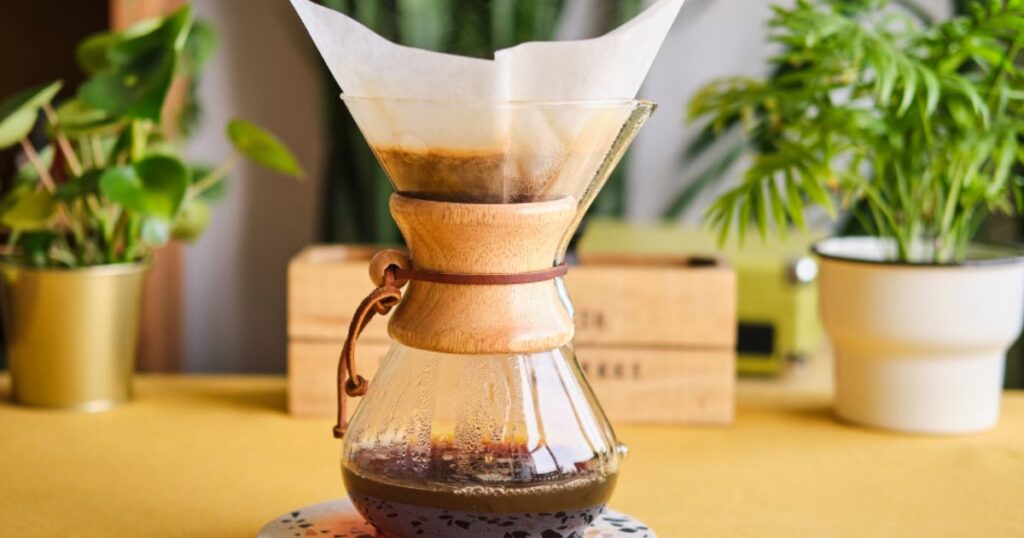
We prefer this method as it’s quick, delectable, and packed with caffeine.
Step 1: Gather Tools and Ingredients
What you need is light to medium roast coffee beans, a weighing scale, and a pour-over filter kit. Heat the water just close to boiling temperature in a kettle and let it sit.
Next, place the carafe or Chemex on the weighing scale and add ice cubes until you reach 250 g. Apply a paper filter onto the pour-over brewer and rinse it to remove any residual taste. Place the brewer over the top of the carafe.
Step 2: Adding Coffee
Grind 30 g of coffee to a medium-fine consistency and add it to the filter. Shake it a bit to let it settle evenly. Now, slowly pour hot water (60 g) and stop once all the coffee grounds are soaked. Let it bloom for 45 sec. The coffee will slowly start dripping over ice.
Step 3: Add Remaining Hot Water
Now, pour the remaining hot water in a circular fashion, aiming for a total of 275 g of water in the final brew. This will result in a single, large 10-16 oz serving.
Give it a little swirl. There is no need to add extra ice as the previous one will not completely melt and is enough to keep the beverage cold.
Enjoy your delicious filter-style cold coffee.
Pro tip: You can also make coffee ice cubes instead of regular ice by pouring your black coffee into an ice cube tray and letting it freeze. This way, you’ll get a higher caffeine kick without any dilution.
Method 3: Simple Iced Coffee
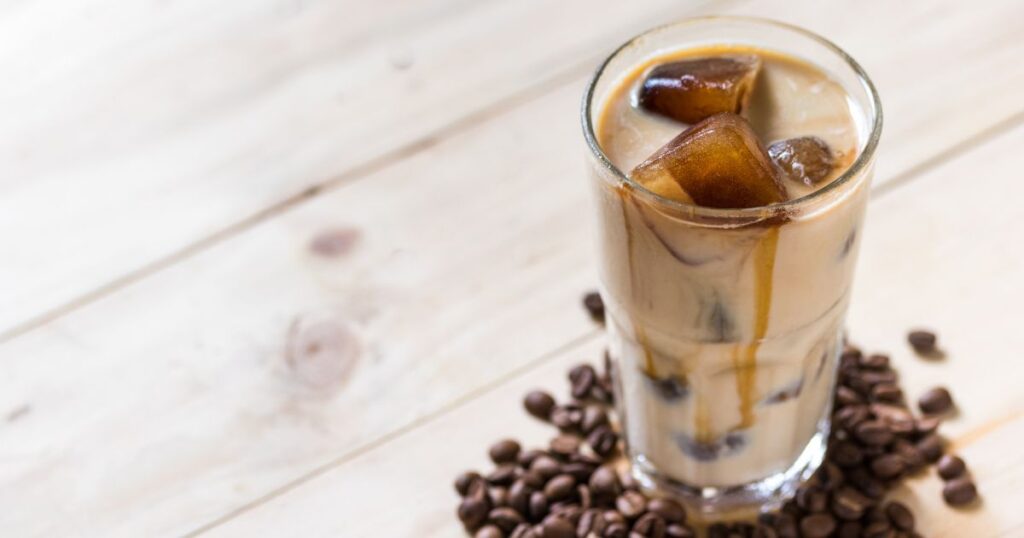
A simple yet delicious frappe iced coffee recipe.
Step 1: Pouring All the Ingredients In A Blender
Add ¾ cups of cold water, 1-2 teaspoons of instant coffee, 2 tablespoons of half-and-half cream, and 3 teaspoons of sugar into a blender. Blend it for a couple of minutes.
Step 2: Add Ice
Pour the mixture into a glass and add ice cubes to your liking. Give it a stir, top it with whipped cream, and you’ll have a refreshing summer frappe drink.
Creamer Variations
Add milk and sweeteners to your taste. Popular dairy options are:
Whole milk: It’s a regular milk with 3.25% fat and, in most cases, isn’t chemically altered.
Vegan milk: Plant-based milk like coconut milk, almond milk, and soya milk. A good alternative to whole milk.
Half and half cream: Simply a blend of equal parts whole milk and heavy cream. It’s best for adding creamy and velvety texture to coffee.
Some also like to add coffee creamer, which is a dairy-free product processed with sugar, oil, and thickeners. But we recommend sticking to natural sources for good health.
Iced Coffee Recipe (Japanese Style Cold Coffee)
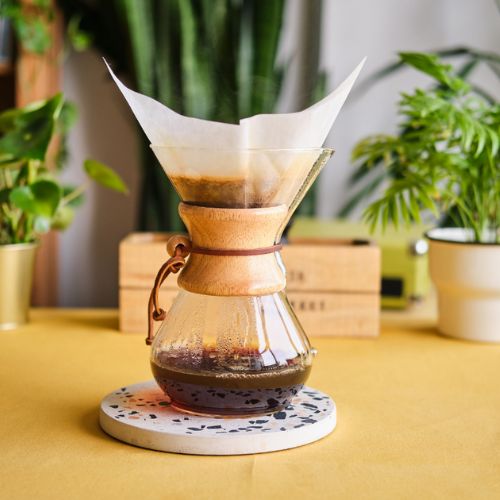
Equipment
- Pour-over filter kit
- Coffee grinder
- Kettle
- Coffee Cup
- Kitchen Scale
Ingredients
- 2-3 tbsp Medium Roast Coffee: 30-35 grams
- Hot Water
- Ice cubes
Instructions
- Heat water to boil and let it sit for a few seconds. In the meantime, grind coffee beans to medium fine consistency.
- Place the carafe or Chemex over kitchen scale and add ice cubes until the weight reaches 250 g.
- Apply filter paper to pour-over brewer and rinse it.
- Add coffee grind into the brewer and shake it to make the coffee bed even.
- Pour hot water slowly until all the coffee grinds are soaked, and wait 45 sec for the blooming process.
- Now, add the remaining water slowly in a circular fashion. Keep an eye on the scale. Aim for 275 g of water in the final brew.
- Remove the pour-over brewer when the dripping stops. Stir and serve with the ice already present in the carafe. Avoid adding extra ice, as it will dilute the taste.
- Add milk or sweeteners to taste.
- Enjoy your refreshing iced coffee.
Why Is an Iced Coffee Layered?
Layering is important in iced lattes as it adds nuance to the overall flavor. Pour coffee over the ice and milk to maintain the necessary temperature difference, which keeps the ingredients separated.
What Type of Coffee To Use For Iced Coffee?
Any type of coffee can be turned into a delicious, iced coffee drink. Some recipes include espresso as a base, while others use drip, pour-over, and even instant coffee as the main ingredient. It all depends on the type of iced coffee you want to drink.
What Type of Ice Is Best For Iced Coffee?
Ice cubes made with clean and filtered water are best for iced coffee drinks. To avoid extra dilution, you can use coffee ice cubes, which are simply black coffee but frozen.
Also, be mindful of ice cube shapes and sizes, which typically come in crushed, medium, and large cube shapes. We recommend using medium-sized ice cubes as they are easy to weigh and store.
What Is the Difference Between Iced Coffee and Cold Brew Coffee?
Iced coffee and cold brew are two different variations of cold coffee beverages. Cold brew is brewed by mixing coffee grounds with cold water, which then is cooled in a refrigerator for 12-24 hours. The longer extraction time and cool temperatures produce a less acidic yet full-bodied coffee drink.
Also, iced coffee can be referred to as any type of cold coffee from Japanese-style iced filter coffee or Greek frappe, made with hot brewing methods but served chilled with ice cubes.
Typically, the recipes include a higher coffee-to-water ratio for countering dilution. Iced coffee has a more in-depth flavor and is slightly more acidic and bitter than cold brew.
Types Of Iced Coffee – Iced Coffee Flavors
Summer is here, bringing exciting new flavors of iced coffee to enjoy. Here is the list of iced coffee flavors coffee drinkers love.
Iced Caramel Macchiato
Popularized by Starbucks. It’s a refreshing blend of ice, milk, espresso, and vanilla syrup topped with sweet caramel syrup.
Iced Vanilla Latte
A cool drink made from frothed milk, iced vanilla syrup, and double espresso shots.
Iced Mocha
Similar to regular mocha but much cooler. An exciting mix of cocoa powder, cream, coffee, and, of course, ice.
Baileys Iced Coffee
Baileys Irish cream coffee liqueur mixed with freshly brewed coffee and served chilled with ice.
Iced Espresso
Double shots of espresso pulled straight on the ice cubes. Instead of espresso machine you can use stove moka pot coffee maker.
Iced Cappuccino
Frothy milk with just enough micro-foam poured over ice and then topped with a single shot of espresso.
Iced Latte
Similar to an iced cappuccino but twice the amount of milk and a single shot of espresso.
Frequently Asked Questions
Is Iced Coffee Healthy for You?
Yes, iced coffee is as healthy as any other coffee. It’s also less acidic than hot coffee. It does have higher caffeine, so keep the consumption limited to 32 oz a day, which is close to 400 mg of caffeine, as recommended by Health professionals.
Is Iced Coffee Just Coffee with Ice Cubes?
No, iced coffee is not just coffee with ice cubes. Iced coffee is a standalone drink with its recipes and flavor profile., You can make ice cubes with coffee, which works like regular ice cubes, but don’t dilute the coffee drink.
Is It OK To Drink Iced Coffee Every Day?
Yes, it's safe to drink iced coffee every day. Just make sure to consume one or two pints (32 oz) a day to avoid caffeine overdose. Also, be mindful of the calories if you're adding cream and other sweeteners to the mix.
Can I Use Normal Coffee for Iced Coffee?
Yes, iced coffee has the same coffee base as regular hot coffee, but the only difference is in the coffee-to-water ratio, which is kept higher to avoid watering down the taste because of extra water in the form of ice cubes.
Is Iced Coffee Good for Losing Weight?
Iced coffee has a higher caffeine content in it, which can boost metabolism and provide the necessary antioxidants for weight loss. However, you need to be mindful of adding milk and sugar to the coffee, which can add excessive calories to your diet. It’s best to consume iced coffee in the morning to support weight loss.
Which Iced Coffee Is the Healthiest?
A simple black iced coffee or a cold brew without any additives is always the healthiest option.
How Do You Sweeten Iced Coffee Without Sugar?
You can add sugar alternatives like stevia and monkey fruit, making your drink sweet without adding the dreaded calories. Honey is also a natural sweetener you can try. Adding milk and cream can also reduce the bitterness and increase the sweetness of the drink.
Can You Chill Regular Coffee to Make Iced Coffee?
Yes, you can, but it’s not preferred because chilling regular coffee drinks neutralize the coffee taste, aroma, aromatic oils, and bitterness of the coffee. So, it’s best to brew iced coffee with a higher coffee-to-water ratio from the start to keep the flavors intact.
Can You Make Iced Coffee with Just Cold Water?
Yes, however, cold brews are typically made with cold water, but some recipes include using hot water at first before adding cold water to kick start the blooming process, which helps extract more flavor in the final brew. On the contrary, Iced filter coffee requires hot water during the prepping phase, and the drink is chilled with ice cubes later.
What Is the Ratio Of Coffee To Water For Iced Coffee?
A good coffee-to-water ratio would be 1:10 for iced coffee, which means adding 10 g of water for every 1 g of coffee. Higher coffee content helps retain the flavors that are otherwise lost due to low temperatures.
How Long Does Iced Coffee Last in The Fridge?
Regular iced coffee or cold brew stored in air-tight containers with no additives can last 4 to 7 days in a fridge. If you are storing milk-based coffee like an iced latte, then don’t store it for more than three days.
Summary
In this guide, we’ve explored the variety of iced coffee drinks that summer has to offer. For all the coffee lovers out there, try out our recipes and feel free to experiment, making them your own.
Iced coffees are served in larger amounts because they have a milder taste than their “hot cousins,” but they still have a higher caffeine content, so be mindful of how many pints you consume daily.
Here’s to endless summers and satisfying sips!

